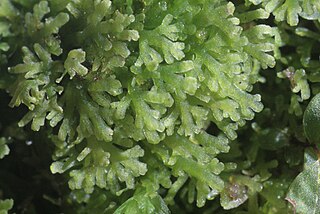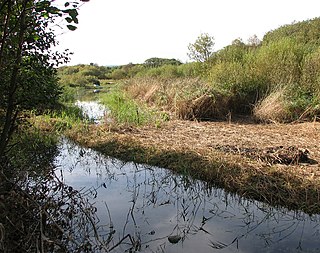
The Marchantiophyta are a division of non-vascular land plants commonly referred to as hepatics or liverworts. Like mosses and hornworts, they have a gametophyte-dominant life cycle, in which cells of the plant carry only a single set of genetic information.

Metzgeriales is an order of liverworts. The group is sometimes called the simple thalloid liverworts: "thalloid" because the members lack structures resembling stems or leaves, and "simple" because their tissues are thin and relatively undifferentiated. All species in the order have a small gametophyte stage and a smaller, relatively short-lived, spore-bearing stage. Although these plants are almost entirely restricted to regions with high humidity or readily available moisture, the group as a whole is widely distributed, and occurs on every continent except Antarctica.

Marsupella profunda, the western rustwort, is a liverwort native to Europe and known only from Portugal and Great Britain (Cornwall) and has been sighted in the Canary Islands. It is a small reddish liverwort and can be confused with Marsupella sprucei which has a more widespread distribution.

Jungermanniopsida is the largest of three classes within the division Marchantiophyta (liverworts).

Helodium blandowii, also known as Blandow's helodium moss, Blandow's tamarisk-moss, Blandow's bogmoss, and Blandow's feathermoss, is a common moss species in Europe. It is also found in North America, Central Asia and Greenland. It is considered rare plant in the Western U.S., including Oregon and California. It occurs all around the northern hemisphere in higher latitudes, and in some places is not as rare as in the Western U.S.

Cavicularia densa is the only species in the liverwort genus Cavicularia. The species was first described in 1897 by Franz Stephani, and is endemic to Japan, where it grows on fine moist soil.

Biantheridion is a genus of liverwort in the family Anastrophyllaceae. Its only accepted species is Biantheridion undulifolium the marsh flapwort, or marsh earwort. It is found in Austria, China, the Czech Republic, Denmark, Finland, France, Germany, Greenland, North Korea, Norway, Poland, Russia, Sweden, Switzerland, and the United Kingdom. Its natural habitat is swamps. It is threatened by habitat loss.
Lejeunea drehwaldii, synonym Sphaerolejeunea umbilicata, is a species of liverwort in the family Lejeuneaceae. It is endemic to Colombia. Its natural habitat is subtropical or tropical moist lowland forests.

The Dawlish Warren National Nature Reserve is a national nature reserve near the village of Dawlish Warren in south Devon, England. It is part of the Exe Estuary Special Protection Area, and sits on a sand spit which runs across the mouth of the estuary. It is also a Site of Special Scientific Interest and part of it is a local nature reserve.

Aneura mirabilis is a parasitic species of liverworts in the family Aneuraceae. It was first described in 1933, as Cryptothallus mirabilis. Plants of this species are white as a result of lacking chlorophyll, and their plastids do not differentiate into chloroplasts.

Ptilidium is a genus of liverwort, and is the only genus in family Ptilidiaceae. It includes only three species: Ptilidium californicum, Ptilidium ciliare, and Ptilidium pulcherrimum. The genus is distributed throughout the arctic and subarctic, with disjunct populations in New Zealand and Tierra del Fuego. Molecular analysis suggests that the genus has few close relatives and diverged from other leafy liverworts early in their evolution.
Petalophyllaceae is a family of liverworts in the order Fossombroniales. Most species are thallose; that is, the plant is not differentiated into root, stem, and leaf. The thallus is typically small and bears lamellae on its dorsal surface that give it a ruffled, leafy appearance.

Riella is a genus in the liverwort family Riellaceae, and includes about eighteen species. Plants in the genus are small and grow submerged in shallow temporary pools. Although the genus is widely distributed in the Northern Hemisphere, locating populations is often difficult. Its occurrence is sporadic and local, and the tiny plants are ephemeral. The ornamented spores remain viable for several years, allowing the plants to survive annual drying of their habitat. The plants are easily grown in laboratory cultures.

Ptilidium ciliare is a liverwort with the common names ciliated fringewort and northern naugehyde liverwort. It is widespread in Canada, Alaska, the northeastern United States, Greenland, Iceland, and northern Europe occasionally as far south as northern Italy.

Mylia taylorii, or Taylor's flapwort, is a species of leafy liverwort.

Rhizomnium punctatum, also called dotted thyme-moss, is a small species in the genus Rhizomnium.

Marchesinia mackaii, or MacKay's pouncewort, is a species of leafy liverwort.
Petalophyllum, or petalwort, is a genus of liverworts in the order Fossombroniales.
Petalophyllum americanum, common name petalwort, is a species of liverwort in the order Fossombroniales. It is endemic to the Gulf Coast of the United States in Arkansas, Louisiana, Mississippi, and Texas. It was first described as the European species Petalophyllum ralfsii in 1919, but a detailed study later showed that the North American form is a distinct species.
Endogemma is a monotypic genus of liverworts belonging to the family Endogemmataceae and subclass of Jungermanniineae.














